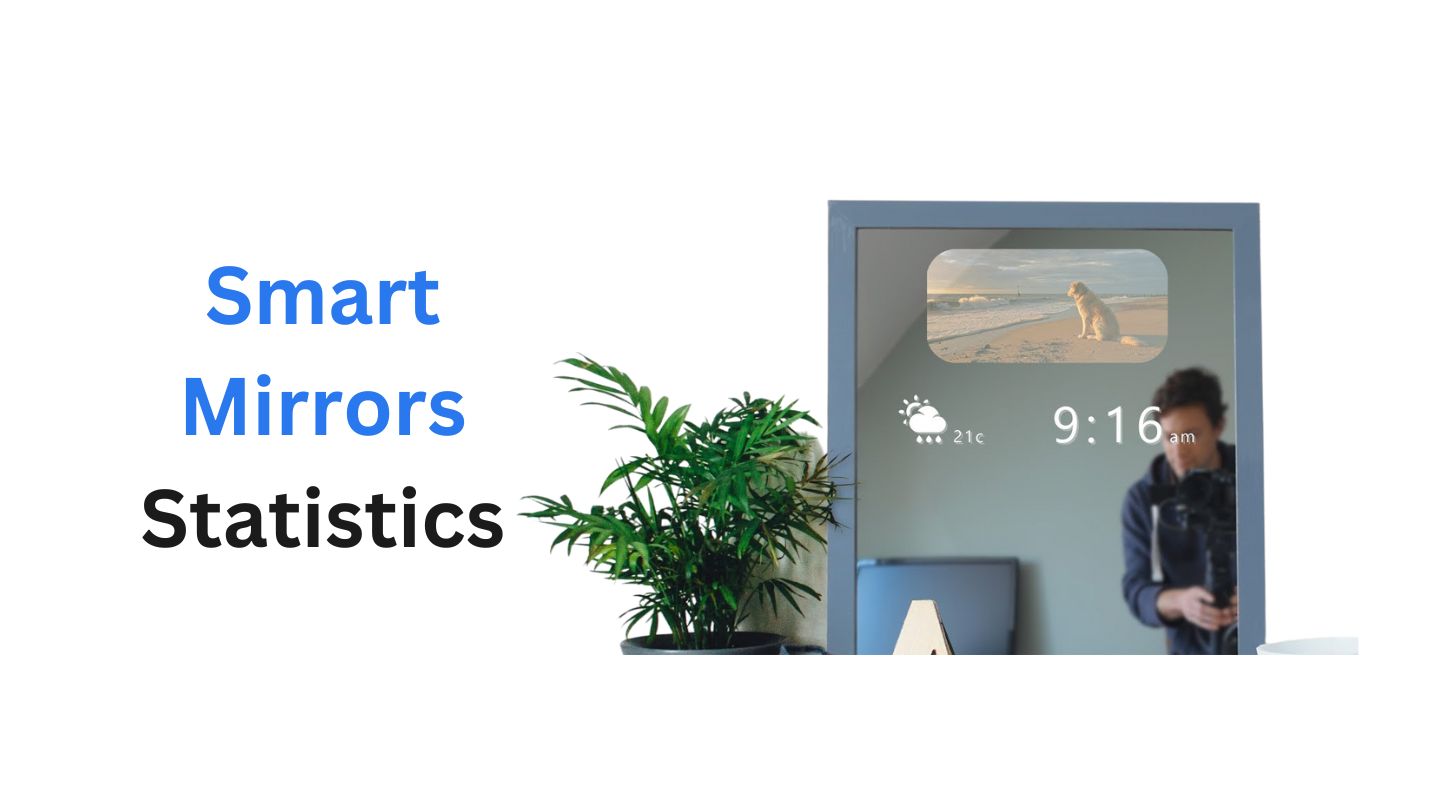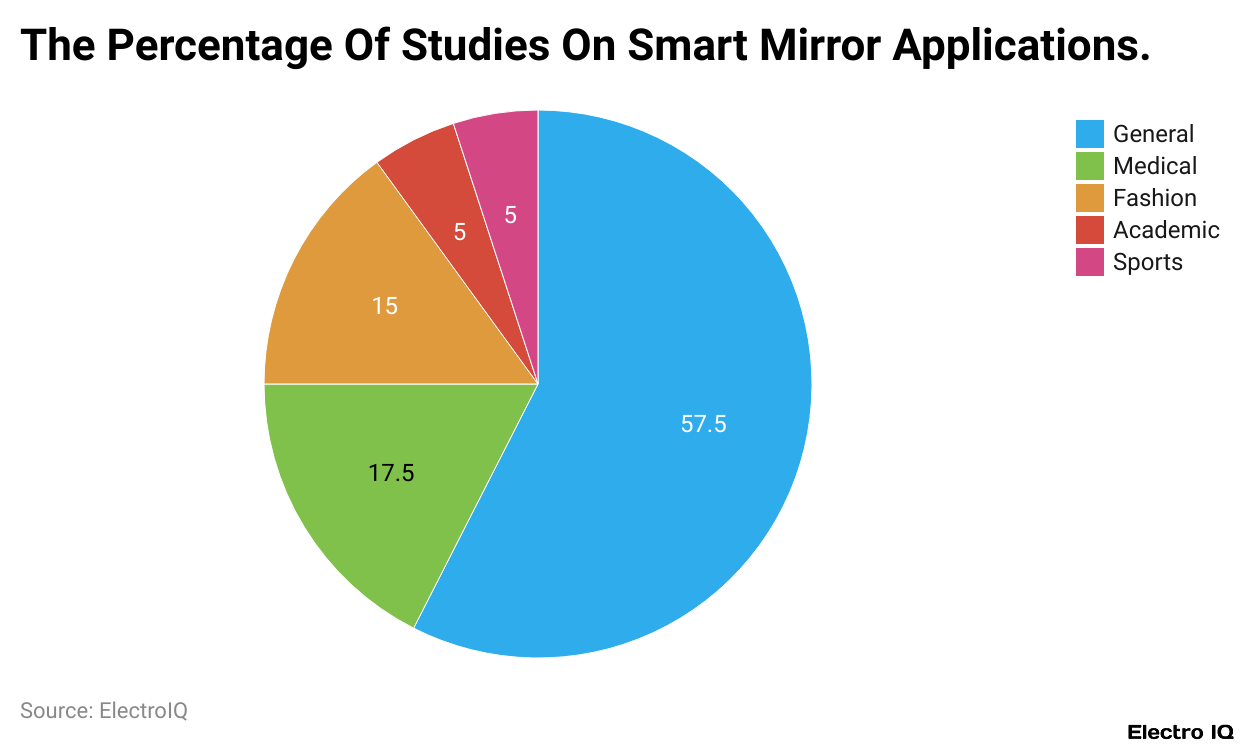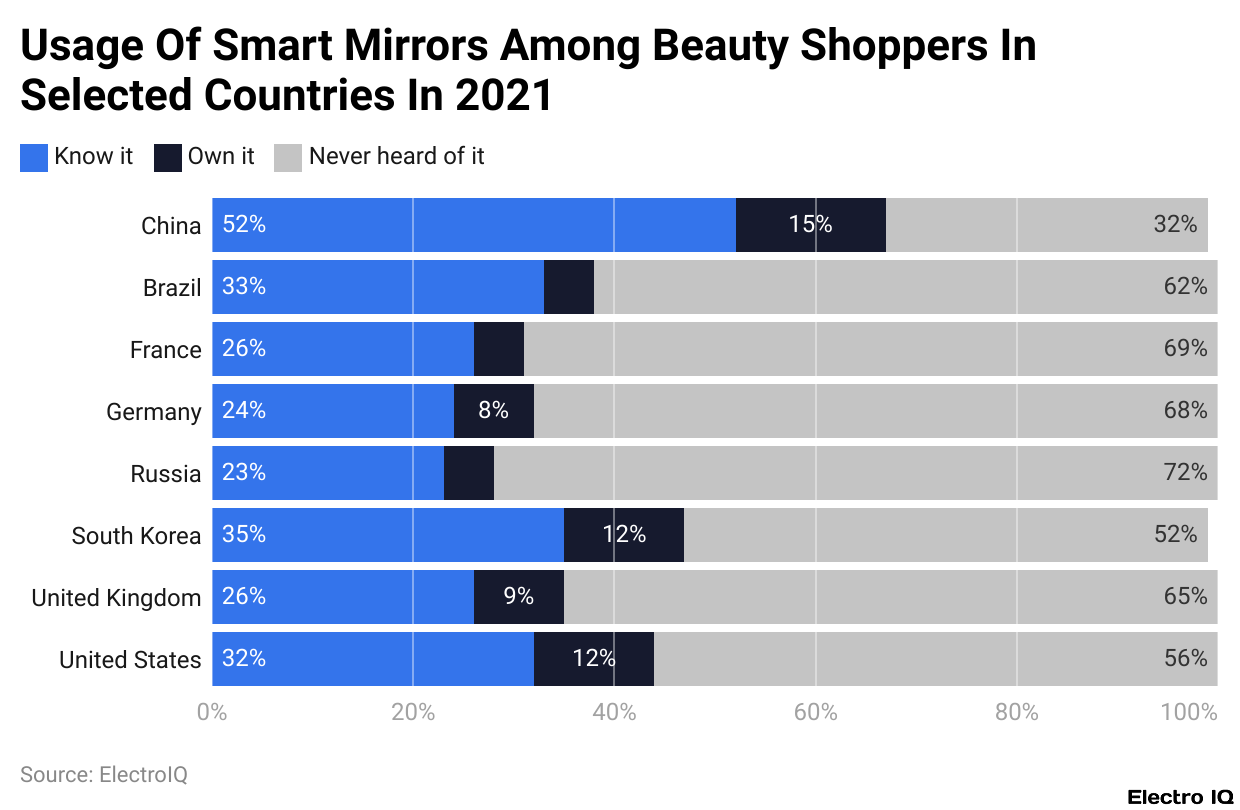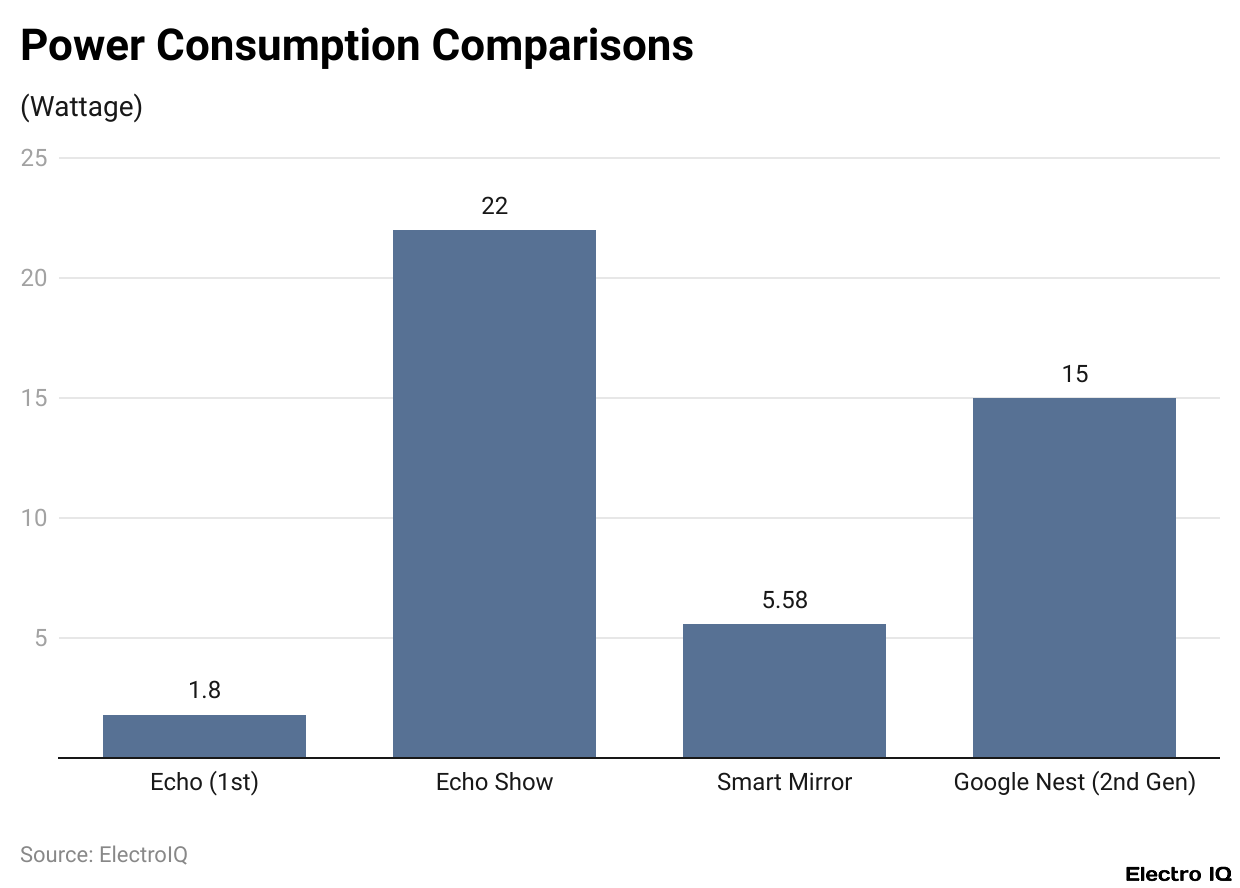Smart Mirrors Statistics By Market Size, Application, Usage and Facts
Updated · Feb 11, 2025

Table of Contents
- Introduction
- Editor’s Choice
- Smart Mirror Market Size
- Smart Mirrors Statistics By Application
- Smart Mirrors Website Traffic
- Cost Of Smart Mirrors
- Smart Mirror Growth Drivers
- Smart Mirrors Usage
- Smart Mirrors Statistics By Country
- Smart Mirrors Power Consumption Compared To Other Devices
- Recent Developments
- Conclusion
Introduction
Smart Mirrors Statistics: Smart mirrors are an advanced technology that merges conventional reflective surfaces with various innovations and interactivity, displaying information, entertainment, and personalized content for users. They can be applied in different areas or fields, including automotive, retail, healthcare, and residential.
As of 2025, increased growth in the market of smart mirrors statistics has been due to technological enhancements and the rapidly increasing consumer demand for smart home devices.
Editor’s Choice
- The global smart mirror market was valued at approximately USD 2.8 billion in 2018 and is projected to grow at a CAGR of 9.41% from 2018 to 2023.
- In 2023, 57.5% of smart mirror applications were used in general stores, followed by 17.5% in medical, 15% in fashion, 5% in academic, and 5% in sports sectors.
- Interactive mirror market revenue increased from USD 2.7 billion in 2022 to USD 3.68 billion in 2024, and is expected to reach USD 14.9 billion by 2033.
- Smart Mirror website traffic averages 10,000 hits monthly, with 49% of traffic coming from organic search, and a 58% bounce rate, with a median rate of 70%.
- Compact smart mirrors in America are priced below USD 100, mid-size mirrors range from USD 150 to USD 300, and large mirrors cost more than USD 400. In Europe, smart mirrors cost between €100 to €800, and in India, they range from ₹5,000 to ₹50,000+.
- Smart mirrors are available in more than 128 million households in the U.S., with 14 million incorporating smart technology.
- The number of IoT devices in the U.S. is projected to reach 3.63 billion in 2024, contributing to the adoption of smart mirrors.
- There are 283.4 million registered vehicles in the U.S. equipped with AI-based smart rearview mirrors, while the retail sector uses smart mirrors for virtual try-on technology.
- 15% of beauty shoppers in China own smart mirrors, making it the country with the highest rate of ownership, while over half of consumers in China are aware of smart mirrors.
- The U.S. market remains competitive with significant players impacting the global market for smart mirrors from 2024 to 2030.
- The power consumption of smart mirrors is rated at 5.58 W, compared to 1.8 W for Echo, 22 W for Echo Show, and 15 W for Google Nest.
- Gentex Corporation invested in ADASKY to enhance smart mirror technology, and Magna International made a USD 470 million investment in Canada to support electric vehicle innovations.
- North America leads in smart mirror adoption, while Asia-Pacific, particularly China, Japan, and South Korea, are emerging as key markets.
Smart Mirror Market Size
 (Reference: statista.com)
(Reference: statista.com)
- The global smart mirror market has seen steady growth over the years. In 2018, the total value of the market was estimated at around USD 2.8 billion.
- Smart mirrors statistics state that Between 2018 and 2023, the market was anticipated to grow at a compound annual growth rate (CAGR) of 9.41%.
- The driving forces for the market have thus been the development of smart technology, increasing consumer interest in smart home devices, and applications of smart mirrors in various industries, including automotive, retail, and healthcare.
- The increasing popularity of interactive and AI-enabled mirrors has added to the ever-growing market demand, thus becoming one of the critical segments in smart technology.
Smart Mirrors Statistics By Application
 (Reference: enterpriseappstoday.com)
(Reference: enterpriseappstoday.com)
- Smart mirrors statistics show that in 2023, general stores were the most popular applications for smart mirrors, forming a sizeable 57.5% share of the market.
- By integrating virtual try-ons, personalized advertising, and interactive displays that guide customers in making informed purchasing decisions, these mirrors truly added value to the shopper experience.
- Next to general stores, the medical sector accounted for 17.5% of the market share, where smart mirrors featured in health monitoring, telemedicine, and hygiene in hospitals and clinics.
- Close on their heels, with a share of 15,% was the fashion industry, which incorporated smart mirrors in both boutiques and retail stores to allow customers to virtually try on outfits and receive styling advice.
- Academic institutions made up 5% of smart mirror applications, where smart mirrors were used mainly for interactive learning, facial recognition-based attendance systems, and digital information boards.
- 5% of the sports segment employed smart mirrors in fitness centers and gyms to correct posture, help with workout recommendations, and track performance. Smart interactive mirrors have become an integral feature in hospitality establishments such as hotels and spas, providing guests with a unique and immersive experience that goes well beyond the conventional.
- Smart mirrors statistics state that the interactive mirror market revenue was recorded at USD 2.7 billion in 2022, witnessing an increase to USD 3.15 billion in 2023.
- Further along the same growth line, revenues mounted up to USD 3.68 billion in 2024 and to USD 4.3 billion in 2025. Maintained growth was recorded for the coming years, where the market reached USD 5.02 billion in 2026 and beyond, finally attaining USD 5.86 billion in 2027.
- In the continued momentum of this market, revenue passed USD 6.85 billion in 2028 and saw a boom to USD 8 billion in 2029.
- As the industry kept blossoming, figures soared to USD 9.35 billion in 2030 and USD 10.92 billion in 2031.
- Having stayed on the growth curve, revenues continued to leap to USD 12.75 billion in 2032 and further up to USD 14.9 billion in 2033, proving to record the constant and appreciable growth of market size since the past years.
Smart Mirrors Website Traffic
- The survey was conducted among 400 web professionals, who presented key thought pieces regarding website traffic for smart mirrors.
- The survey results indicate that, on average, these smart mirror websites have approximately 10,000 visitors per month, while the median website receives about 1,000 visits per month.
- Smart mirrors statistics indicate that 50% of the websites receive, at best, 500 visits per month. As for the source of traffic, the largest share, 49%, comes from organic search.
- Other traffic sources in 2023 were direct traffic-wise, which took up 17% share, social media %, paid search 5%, referral traffic 4%, and the remaining 18% from other various channels.
- Furthermore, it was noted in the study that smart mirror websites had an average bounce rate of 58%, while the median bounce rate was significantly higher at 70%.
Cost Of Smart Mirrors
- Smart mirrors statistics state that in the United States, compact smart mirrors cost under USD 100; the medium ones are generally between USD 150 and USD 300, while the larger ones can be over USD 400.
- The preferred system for these smart mirrors is the Raspberry Pi, and the complete kit, including all necessary connectors, costs about USD 50 to USD 80.
- Applying a special film on normal glass usually costs around USD 20 to USD 50, while good-quality plexiglass is about USD 150. A good-quality two-way mirror may cost about USD 200.
- An average smart mirror in India costs between ₹5,000 – ₹10,000, with advanced models with bigger screens and more features ranging anywhere between ₹15,000 – ₹50,000 or more.
- In Europe, basic smart mirrors generally go for between €100 – €200, while advanced ones with bigger screens and enhanced features are priced around €300 – €800 and above.
Smart Mirror Growth Drivers
- Connected homes have emerged as one of the major drivers in the smart mirror market in the United States.
- As per the smart mirrors statistics, as of 2024, in the United States, over 128 million households exist, with more than 14 million already having some form of smart technology.
- The rapid adoption of connected devices for energy management and home automation has also been reported by the U.S. Department of Energy as energy-efficient living spaces gain focal attention.
- The integration of AI and IoT is transforming the U.S. smart mirror market.
- The estimated number of connected IoT devices in the United States in 2024 is approximately 3.63 billion.
- AI-driven features like facial recognition and personalized settings based on user preferences are fast becoming popular as consumers prefer advanced interactive technology.
- This trend is further propelled by an increasing demand for seamless connectivity of devices and AI-powered analytics. Smart mirror adoption is also growing in the automotive and retail customer engagement sectors.
- By 2024, there will be 283.4 million registered vehicles in the United States, with a growing number integrating AI-powered smart rearview mirrors for driver assistance and safety enhancement.
- At the same time, in retail, smart mirrors are innovating shopping experiences by applying virtual try-on technology, thus reshaping customer interaction with products in stores.
Smart Mirrors Usage

- According to Smart mirrors statistics on the Global Consumer Survey on Beauty & Cosmetics executed in 2021, it was observed that the awareness of smart mirrors was much stronger in China than in other nations.
- About 51% of surveyed consumers were familiar with the idea of smart mirrors that allow instant application for a virtual try-on of beauty products; on the other hand, most respondents in the other studied countries stated that they never heard of the term “smart mirrors.”
- In terms of ownership, China also led, with 15% of beauty shoppers reported to have one in their possession. Hence, beauty technology is comparatively more accepted in the Chinese market than in other regions.
Smart Mirrors Statistics By Country
United States
- The smart mirror market in the United States is characterized as being at some active stage, which gives an active opportunity for key competitors to pass through this market in 2025.
- The entire U.S. smart mirror market is appraised based on application—namely, automotive, hospitality, retail, and others—and independent annual sales figures in USD million from 2024 to 2030, as well as the compound annual growth rate (CAGR) calculated in the ever-evolving industry.
- A six-year outlook summarises the percentage breakdown of value sales across these applications for 2025 and 2030.
- The outlook also covers the analysis of the market in terms of components, i.e., hardware, software, and services, along with individual annual sales forecasts from 2024 to 2030 and the respective CAGR.
China
- In China, smart mirror markets can be classified as Strong/Active/Niche/Trivial, whose landscapes will be set by some key competitors after 2025 (E).
- Trajectories of the past, present, and future have been attempted in a detailed discussion of the smart mirror market applications, including automotive, hospitality & retail, and other sectors, providing independent annual sales figures in US million from 2024 to 2030 with CAGR percentages.
- This is complemented by a six-year outlook that presents the application-by-application distribution of sales value for the years 2025 and 2030.
- The smart mirror market in China is also analyzed on hardware, software, and services, excluding annual revenue projections from 2024 to 2030 wherein the CAGR is analyzed.
- A six-composition gives a break-up of percentage share value sales in hardware, software, and services for 2025 and 2030.
Europe
- The European smart mirror market spectrum is Strong/Active/Niche/Trivial, with the key competitors anticipated in 2025 (E).
- The market analysis includes a thorough analysis of the past present and future potential for growth concerning applications from automotive, hospitality & retail, and others, along with independent sales analysis in US million for the period 2024-2030 about CAGR.
- A six-year outlook also provides the percentage breakdown of sales value by application for the years 2025 and 2030.
- Further, the smart mirror market of Europe has been judged based on the geographical segmentation for regions that include France, Germany, Italy, the UK, and the Rest of Europe.
- The independent sales analysis in USD million for each region from 2024 to 2030, together with CAGR insights, is represented.
France
- France’s smart mirror market presence is classified as Strong/Active/Niche/Trivial, with key competitors projected for 2025 (E).
- The trends in the country are analyzed across different applications, including automotive, hospitality & retail, and other sectors, with independent annual sales figures in USD million for 2024 to 2030, along with CAGR insights.
- The analysis will also be made based on market components, including hardware, software, and services, including independent revenue forecasts and CAGR from 2024 to 2030.
Smart Mirrors Power Consumption Compared To Other Devices

(Reference: researchgate.net)
- According to smart Mirror statistics, When contrasting the power consumption across various classes of smart devices, the wattage will vary depending on type and functionality.
- The first-generation Echo uses just 1.8 watts and is, therefore, energy efficient in terms of voice assistant work; in stark contrast, the presence of a display and extra features puts the Echo Show in the higher range of power consumption, at 22 watts.
- Power-wise, a smart mirror-combining interactive display with smart functions uses 5.58 watts, which neatly fits between the lower-powered Echo and the more power-sucking Echo Show.
- The second-generation Google Nest is at 15 watts, meaning it uses more power than a smart mirror but less than the Echo Show, indicating an enhancement in features about home automation and assistance.
Recent Developments
- Smart mirrors statistics reveal that Gentex Corporation announced an investment in ADASKY, a top-level company in Long Wave Infrared (LWIR) sensor technology.
- The purpose of this investment is to fuse ADASKY’s proprietary technology into smart mirror functions in the markets to enhance safety and performance features.
- In February 2023, Magna International announced a strategic investment of 470 million USD in the expansion of operations in Ontario, Canada, namely in the creation of a facility for battery enclosures to support electric vehicles aligned with Magna’s strategies toward smart mirror technology.
- In January 2022, Seura launched its new range of vanity mirrors for residential and hospitality use. Integrated with lighting, touch controls, and smart home system connectivity, the devices are produced.
- In December 2021, Capstone Connected announced the Thin Cast Smart Mirror, which featured an 18.5-inch touchscreen display, Android compatibility, and dual speakers, targeting both residential and commercial sectors.
- Gentex Corporation had also led Series B funding for ADASKY, providing the impetus for strong backing and financing necessary for smart mirrors.
- The smart mirror market continues to grow worldwide, buoyed by the increasing adoption of smart home technologies and strides in display and sensor innovations.
- North America remains a big market supported primarily by strong consumer interest in connected devices and smart home solutions. At the same time, the Asia-Pacific region is projected to register robust growth, given the surging demand from China, Japan, and South Korea.
Conclusion
Smart mirror statistics state that the smart mirror market saw a significant milestone since it experienced great growth and technological advancements. As industries keep innovating and integrating smart mirrors into different applications, the market looks forward to further expansion in the coming years.
Sources
FAQ.
The global market for smart mirrors was approximately valued at US$ 2.8 billion as of 2018, having recorded a CAGR of 9.41% from 2018 to 2023. Interactive mirrors accounted for a market revenue of USUS$ 3.68 billion in 2024 and are forecasted to keep growing significantly through to USUS$ 14.9 billion by 2033.
As of 2023, general shops are the biggest users of smart mirrors, which account for 57.5% of the market. Other major industries include medical at 17.5%, fashion at 15%, educational institutions at 5%, and sports sectors at 5%. Smart mirrors are also gaining attention in the automotive and retail sectors, providing an advanced consumer experience.
In the United States, compact smart mirrors are available for under US$100, mid-sized ones are between US$150 and US$300, and large ones are priced over US$400. In Europe, prices vary from €100 to €800, and in India, starting from ₹5,000 to ₹50,000+ depending on size and features.
Smart mirrors’ adoption is greatly influenced by AI and IoT integration. In 2024, the United States boasted around 3.63 billion connected IoT devices for enhancing smart mirror functionalities such as facial recognition, personalised settings, and seamless connectivity with devices. The trend, thus, pushes smart mirror utility in smart homes, automotive applications, and retail experiences.
Recent developments include Gentex Corporation’s stake acquisition in ADASKY with an intention to provide advanced sensor technology to smart mirrors and Magna International’s expansion in Canada to the tune of US$470 million for supporting electric vehicle innovations. In addition, companies such as Seura and Capstone Connected have rolled out new smart mirror models with integrated lighting, touch controls, and compatibility with smart home applications.

Maitrayee Dey has a background in Electrical Engineering and has worked in various technical roles before transitioning to writing. Specializing in technology and Artificial Intelligence, she has served as an Academic Research Analyst and Freelance Writer, particularly focusing on education and healthcare in Australia. Maitrayee's lifelong passions for writing and painting led her to pursue a full-time writing career. She is also the creator of a cooking YouTube channel, where she shares her culinary adventures. At Smartphone Thoughts, Maitrayee brings her expertise in technology to provide in-depth smartphone reviews and app-related statistics, making complex topics easy to understand for all readers.










